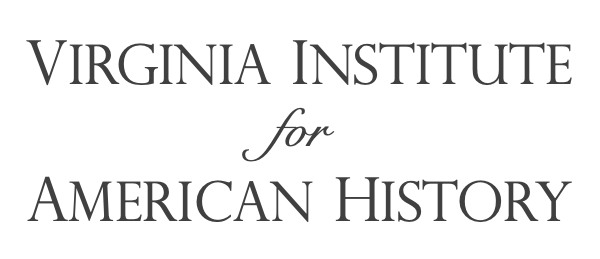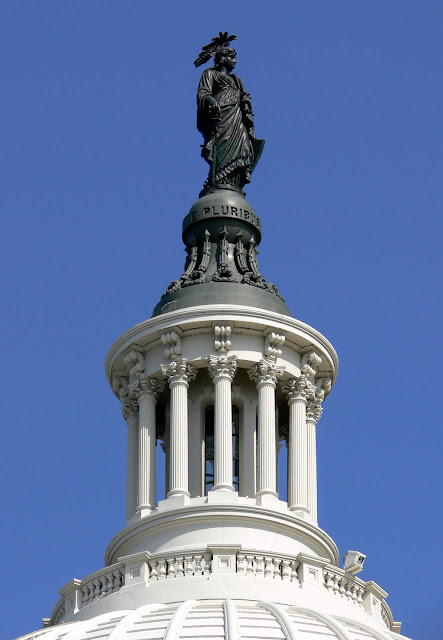The helmet is encircled by nine stars. Ten bronze points tipped with platinum are attached to her headdress, shoulders and shield for protection from lightning. She stands on a cast-iron pedestal topped with a globe encircled with the motto E Pluribus Unum (Out of many, one). The lower part of the pedestal is decorated with fasces (symbols of the authority of government) and wreaths. The pedestal is 18-1/2 feet high and almost doubles the total height. The crest of Freedom’s headdress rises 288 feet above the East Front Plaza.
Statue of Freedom does not wear or hold a knitted liberty cap, as would have been expected in nineteenth-century art. The knit cap provided to freed slaves in ancient Rome had been adopted as the symbol of liberty or freedom during the American and French Revolutions and was usually shown as red. The Statue of Freedom's crested helmet and sword, suggesting she is prepared to protect the nation, are more commonly associated with Minerva or Bellona, Roman goddesses of war. The history of the statue's design explains why she wears a helmet rather than a liberty cap. The story of her casting reveals that some of the people who worked to create Freedom were not themselves free.
Background & Design Process
A monumental statue for the top of the national Capitol was part of Architect Thomas U. Walter's original design for a new cast-iron dome, which was authorized by Congress in 1855. Walter's first drawing showed a 16-foot statue holding a liberty cap on the long rod with which a slave would be symbolically touched during a ceremony bestowing his freedom in ancient Rome.
Construction Superintendent Captain Montgomery Meigs, who was overseeing the artistic decoration of the Capitol extensions, had already engaged American sculptor Thomas Crawford to create other sculptures for the building, including the Senate pediment. He also had Crawford make models for the two bronze doors and for the figures of Justice and History over the Senate door. Born in New York City, Crawford had established a studio in Rome. His portrait statues and groups of classical and historical figures had earned him a reputation as both talented and prolific.
On May 11, 1855, Meigs wrote to the artist at his studio to commission the statue for the dome. Regarding its subject, Meigs wrote, "We have too many Washingtons, we have America in the pediment. Victories and Liberties are rather pagan emblems, but a Liberty I fear is the best we can get."
Crawford ended up creating a series of three maquettes (preliminary small models) several feet high and sending photographs of them to Meigs for approval. He described his first design with a female figure wearing a wreath of wheat and laurel as "Freedom triumphant—in Peace and War."
However, when Meigs sent him a copy of the drawing for the dome, Crawford realized that his statue needed to be taller and stand upon a more prominent pedestal. He then sculpted a graceful figure in a classical dress wearing a liberty cap encircled with stars, holding a shield, wreath, and sword, which he said represented Armed Liberty. It was sent to Secretary of War Jefferson Davis, who was in charge of the overall construction at the Capitol. Davis objected to the liberty cap, the symbol of freed slaves, because "its history renders it inappropriate to a people who were born free and should not be enslaved." Davis suggested a helmet with a circle of stars. In response, Crawford designed a crested version of a Roman helmet, "the crest of which is composed of an eagle’s head and a bold arrangement of feathers, suggested by the costume of our Indian tribes." This third design was approved by Jefferson Davis in April 1856.
Crawford executed the full-size clay model in his studio in Rome. It was then cast in plaster in five major sections. He died suddenly in 1857 before the model left his studio, and his widow shipped the model, packed into six crates, in a small sailing vessel in the spring of 1858. During the voyage the ship began to leak and stopped in Gibraltar for repairs. After leaving Gibraltar, the ship began leaking again to the point that it could go no farther than Bermuda, where the crates were left in storage until other transportation could be arranged. Half of the crates arrived in New York in December, but all sections were not in Washington until late March 1859.
Beginning in 1860, the statue was cast in five main sections by Clark Mills, whose bronze foundry was located on the outskirts of Washington. Work was halted in 1861 because of the Civil War, but by the end of 1862, with the help of the slave Philip Reid, the statue was finished and temporarily displayed on the Capitol Grounds… Late in 1863, construction of the dome was sufficiently advanced for the installation of the statue, which was hoisted in sections and assembled atop the cast-iron pedestal. The final section, the figure's head and shoulders, was raised on December 2, 1863…”[1]
The Celebration
“A large crowd stood on the U.S. Capitol’s East Plaza, heads tilted back as they looked skyward, 288 feet above them. Even amid the Civil War and frigid temperatures, hopes ran high as the last piece of a massive new bronze statue, Freedom, was deposited on top of the U.S. Capitol’s dome.
As the final piece swung into position, the raising of a Union flag signaled — success!
The crowds cheered, and [thirty-five] cannons [of the twelve forts positioned] around Washington thundered a deafening salute. “Let us indulge the hope,” wrote the National Intelligencer, “that our posterity to the end of time may look upon it with the same admiration.”
After eight years of construction during an unprecedented national crisis, the Capitol’s dome, a symbol of Union and republican government, was crowned with a monumental statue personifying freedom. Although President Abraham Lincoln did not attend the ceremony (he had a mild case of smallpox) his symbolic presence at the event was undeniable.
Just weeks previously, Lincoln spoke about a “new birth of freedom” during his famous Gettysburg Address. The statue carried his imprint; the engineer who installed it stamped “A LINCOLN PRESIDENT” on its feathered headdress, where it remains today.”[2]
_____________________________________
[1] Architect of the Capitol, Statue of Freedom https://www.aoc.gov/explore-capitol-campus/art/statue-freedom
[2] Blake Lindsey, A Tale of Two Symbols: Lincoln and the U.S. Capitol Dome, https://fords.org/a-tale-of-two-symbols-lincoln-and-the-u-s-capitol-dome/
First photo: Andreas Praefcke - Self-photographed, CC BY 3.0, https://commons.wikimedia.org/w/index.php?curid=2268299
Second Photo by Architect of the Capitol


